| Spotlight
Durga Puja Celebrating Together
Rakibul Hasan
Photos: Yamin Tauseef Jahangir

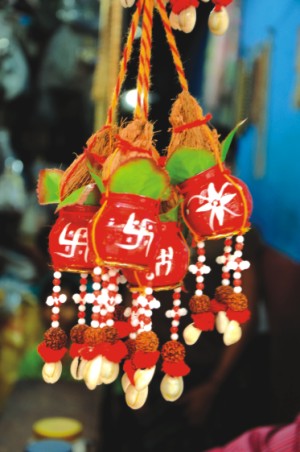 Once again it is autumn. Living in the concrete jungle of Dhaka we can hardly feel any change in the nature surrounding us. However, somehow if we can manage a little escape form the hustle and bustle of this city, we will find the fields covered with Kaash Phool bouncing in the wind and distant beats of dhak from nearby puja mandaps just in the outskirts of the city, reminding us that the festive season of Durga Puja has come to our doors. Once again it is autumn. Living in the concrete jungle of Dhaka we can hardly feel any change in the nature surrounding us. However, somehow if we can manage a little escape form the hustle and bustle of this city, we will find the fields covered with Kaash Phool bouncing in the wind and distant beats of dhak from nearby puja mandaps just in the outskirts of the city, reminding us that the festive season of Durga Puja has come to our doors.
According to the Bengali calendar the season of autumn comprises the months of Ashwin and Kartik. For our farmers these are the months when the harvest is reaped. It is also the time when according to the Hindu scriptures, Goddess Durga along with children, Lakshmi, Saraswati, Ganesha and Kartikeya, comes down to earth. Devi Durga blesses her children of the heaven and earth with the favour of abundance, benevolence and the strength to shun evil with the power of good deeds. Bengali Hindus symbolise the arrival of Goddess Durga on earth with homecoming of bride at her father's abode to meet her kith and keen.
Like all the other major festivals of Bengalis, Durga Puja has become a social festival rather than a mere religious event. From time immemorial Bengalis irrespective of their religions are celebrating Durga Puja as a festival where people from all classes and all communities come together to rejoice.
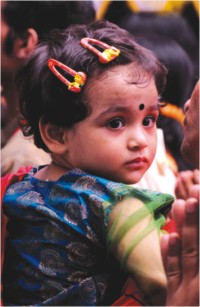 |
| A girl looks on as her brother prays |
As I have spent some precious time of my childhood in a village named Birampur in Sunamganj district, joyful memories of attending the festivities of Durga Puja are still fresh in my mind. I along with some of my friends would visit the village temple nearly a month before the celebration of puja began. The village artisans would work on the structure of the deity with utmost care and devotion. It was amazing to see how the proud effigy of Ma Durga emerged from a lump of earth. When the puja finally began, our joy knew no bounds. It was fun to dance with the pulsating beats of dhak and dhol, to buy toys and muri-murkis from the village fair in front of the puja mandap. There was a wonderful feeling of celebration in the air. Even though my family was Muslim, we never hesitate to accept the invitations of our Hindu neighbours during Bijaya Dashami.
After moving to Dhaka, celebrations of Durga Puja were limited to having feasts at the houses of my Hindu friends. One major attraction was getting fresh copies of puja issues of 'Desh' and 'Anondomela' carrying new novels of Sunil, Sirshendu and Samaresh. However, after getting into University of Dhaka (DU), the scenery changed. The University of Dhaka being the largest public university is the melting pot of students from all religions, cast, creed and culture from all over the country and abroad. The resident male non-Muslim students of DU mainly reside in Jagannath Hall. Each year the staff and students of Jagannath Hall and the university authority jointly organise 'Sharbojonin Durgotshabh'. The major objective of organising puja in Jagannath Hall temple may be religious but one of the most important objectives of this festival is to celebrate the harmony and forbearance among the students of DU.
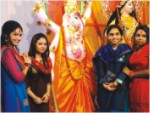 |
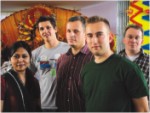 |
| Revelers in front of Ganesha |
Friends from abroad join the celebration |
The festival of Durga Puja includes five days of celebration. Though the actual preparation may begin from months ago, the worship of the goddess is held in the five days of Maha Shasthi, Maha Shaptami, Maha Ashtami, Maha Nabami and finally the Bijaya Dashami. It is the day when the immersion of the idol of Goddess Durga takes place. According to the Puranas the Bijaya Dashami is the auspicious day when Goddess Durga slays the arch demon Mahisasura and proclaims the victory of gods of heaven over the demons of hell. The triumph of good over evil is the message that the grand celebration delivers.
Like every year, I visited several puja mandaps in Dhaka during the five days of Durga puja. My first destination was the puja mandap of Jagannath Hall in the night of Maha Shasthi. After walking through a pathway beautifully decorated with radiant lights, I finally saw the grand effigy of Devi Durga. Proudly standing while riding a lion and wielding a weapon in each of her ten arms, Ma Durga takes care of her children of the heaven and earth with her watchful eyes. Under her foot lies the defeated and slain demon Mahisasura begging for mercy from the embodiment of grace and compassion. At the puja mandap, one will meet a huge number of students from other religious backgrounds. “I presume if an account is made, you will see that majority of the people visiting here are Muslims or people from other faiths as most of the Hindu families in Dhaka are visiting their village homes to enjoy the puja with their relatives” says Subrata one of my friends from Jagannath Hall. “During puja I come to Jagannath Hall to visit friends and to enjoy the festive mood at the puja mandap” says Tareq a student from the Economics department of DU. “Just like my Hindu friends always coming over to my house during Eid, I along with my Muslim friends enjoy the five days of puja with great fun and feasting” says Rehana Akhter a homemaker from Lalabagh, Old Dhaka..
 |
| Duga Puja has inarguably become a festival participated by the whole nation |
Liton Pal, a student from the Department of Sculpture at the Faculty of Fine Arts, was observing the effigy of Devi Durga very attentively. “The combined projection of might and grace at the statue of Ma Durga always inspires me as an artist” says Liton.
In a conversation with Star Campus, Devasish Pal, the House Tutor of Jagannath Hall and a teacher of the Faculty of Fine Arts, DU expressed their satisfaction over the spontaneous participation of students and people from all walks of life at the puja of Jagannath Hall. “The puja was first organised by the resident staffs of Jagannath Hall but now it has become a celebration for all the members of DU family. Nowadays teachers, students and staff of DU, irrespective of their religion, actively participate at the preparation of Durga Puja. “Even during Sharaswati Puja students from Charukala and all the other faculties of DU craft different mandaps in the premises of Jagannath Hall and compete to be the best of the year” adds Devasish Pal.
Gregory Ciupka, an entrepreneur from Poland was visiting the puja mandap with some of his colleagues. I ask him how he feels about this festival. He says, “It's amazing. Before coming to Bangladesh I didn't have any idea a festival so colourful took place here”. “For me it's a little crowded here but the festivity all around is really amazing,” says Orlaf, one of Gregory's friends.
Ramna Kali Mandir on the eve of Mahasaptami was the next destination. Here the best attraction was the fair at the puja mandap. Children were having the time of their lives going about in a merry-go-round while adults were busy buying earthenwares, handicrafts made of canes and other eye-catchy handmade products. Women crowded in front of stalls selling bangles and vermillion. In a corner were stalls filled with delicacies like sugar dolls and muri-murkis, just what the children wait longingly for. Amidst the crowd of devotees, a group of girls wearing burqas caught my attention. “Us friends love to come to the puja.
Friendship knows no religion,” they opined.
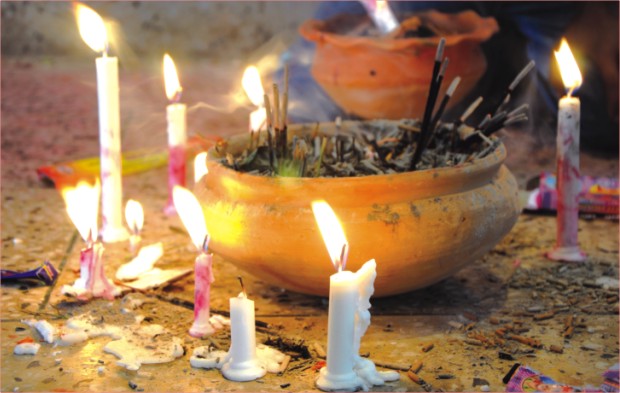
Around 27000 mandaps were built for Durga Puja this year
An old lady in a faded saree sat in front of the goddess with her head bowed down, her face earnest. Perhaps she was longing for a miracle. Abir, an HSC examinee, was also seen with his head bowed, deep in prayers. “I prayed for GPA 5 to Ma,” he smiles.
 |
| Advocate Subrata Chowdhury, President of Bangladesh Sarbojonin Puja Udjapan Parishad |
Sarrah Murray, an American citizen studying in a private university in Dhaka came to see the puja for the first time with some of her friends from Bangladesh. The festive atmosphere everywhere made Sarrah a little nostalgic. “The lights and colours of Durga puja remind me of Christmas at home” says Sarrah.
After relishing a sumptuous feast at a 'pujar nemontonno' (puja party) in a friend's house in the morning of Maha Ashtami, the turn to enjoy the festivity of Puran Dhaka began from Dhakeshwari national temple. The swirling smoke and the smell of burning incense, recitation of Holy Scriptures by the priest set a spiritual ambiance in the age-old temple. Bijoy Kumar Roy working in a private bank, was visiting the temple with his family. “I think Durga Puja is an inseparable part of Bengali culture. The thoughts behind the worship of goddess Durga, the customs practiced during the puja have their roots in ancient Bengali culture,” says Bijoy.
In an interview with the Star Campus, Advocate Subrata Chowdhury, president of Bangladesh Sarbojonin Puja Udjapan Parishad, expressed his gratitude to the present government for creating such a favourable environment to celebrate puja. “I find that in this puja the enthusiasm among people is something like I have not seen in a long time,” says Mr. Chowdhury. “This year the puja is taking place in 27000 mandaps across Bangladesh”. “This year sees the highest number of mandaps crafted in Bangladesh. I have visited quite a number of puja mandaps throughout Bangladesh and have observed the spontaneous participation of people from all religious backgrounds,” declares Advocate Subrata Chowdhury.” He also expressed his satisfaction over the tight security measures taken by the government. As I requested him to share some thoughts of the puja of his youth he told us about the memories of puja during his university life. “I was a student of Rajsahi University. Each year I used to visit our village home with both my Hindu and Muslim friends from university and we passed the days of puja with utmost fun and delight”. Advocate Subrata Chowdhury also reckoned the fond memory of playing dhak.

"Friendship knows no religion " a group of young girls in the celebration are seen together
In another interview with Star Campus, Biresh Chandra Saha, the President of Dhaka Mahangar Puja Committee labeled this year's puja as a showcase of unique religious harmony of Bangladesh. “The avalanche of people in the puja mandaps of city from all religions and social classes to celebrate the festival together proves our secular mindset as a democratic nation,” observes Biresh Chandra Saha.
This year on the day of Bijaya Dashami, the whole nation was flooded with celebrations as Bangladesh cricket team won the series over New Zealand in a clean sweep of 4-0. In the television room of the Jagannath hall the exuberance of hundreds of people were getting louder as the tigers were seconds away to tearing down the Kiwis. Just outside the premise, the final beats of dhaks in the moments of 'bisarjan', the final immersion, were heard. As Bangladeshi player, Rubel Hossain picked up the last wicket of New Zealand the TV room burst out with cheerful slogans. The sorrow of bidding farewell to Ma Durga and on the other hand, the joy of tigers painting the kiwis red and green were shared by the whole nation. These blissful feelings of togetherness always come with the hope to keep marching together as a nation.

The colours, smoke and smell of incense create a spiritual ambience

 |
| One major attraction is a fair in front of the Puja Mandap |
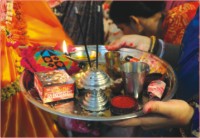 |
 |
 |
| Flame of hope |
Enjoy a light moment |
A moment of quiet devotion |
|

